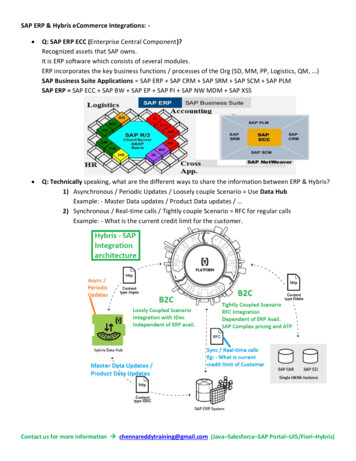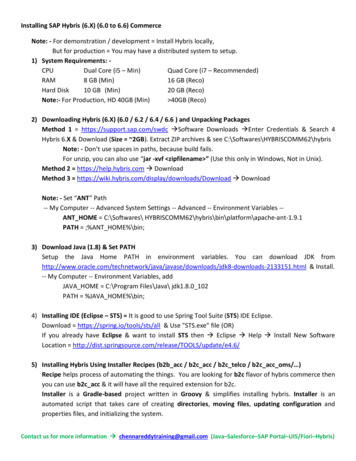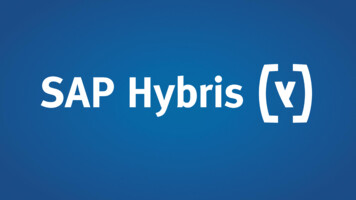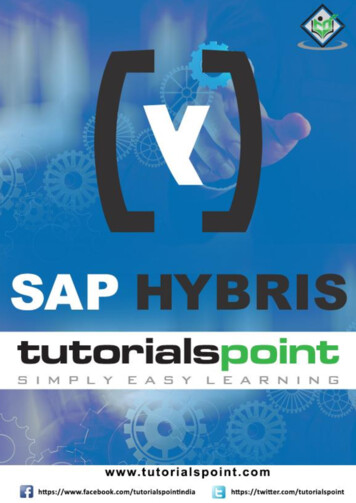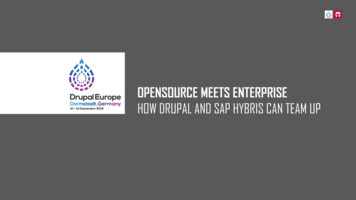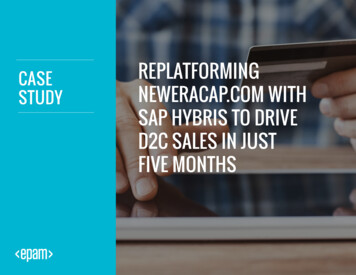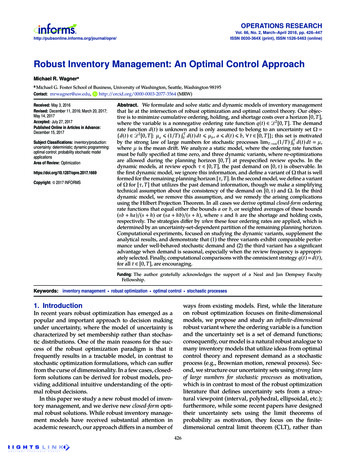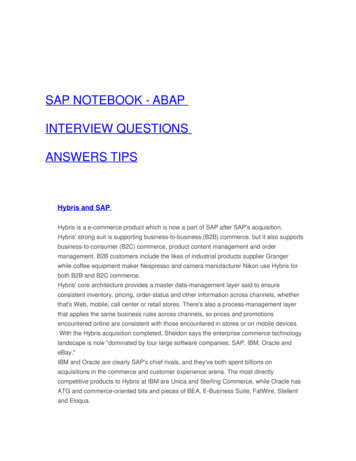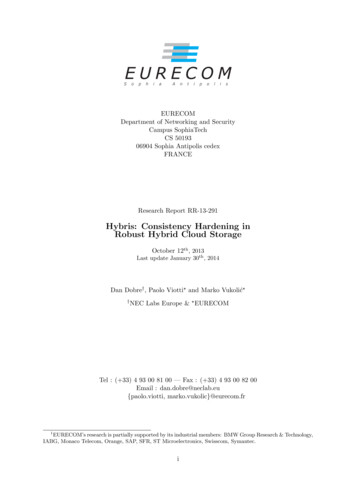
Transcription
EURECOMDepartment of Networking and SecurityCampus SophiaTechCS 5019306904 Sophia Antipolis cedexFRANCEResearch Report RR-13-291Hybris: Consistency Hardening inRobust Hybrid Cloud StorageOctober 12th , 2013Last update January 30th , 2014Dan Dobre† , Paolo Viotti? and Marko Vukolić?† NECLabs Europe & ? EURECOMTel : ( 33) 4 93 00 81 00 — Fax : ( 33) 4 93 00 82 00Email : dan.dobre@neclab.eu{paolo.viotti, marko.vukolic}@eurecom.fr1EURECOM’s research is partially supported by its industrial members: BMW Group Research & Technology,IABG, Monaco Telecom, Orange, SAP, SFR, ST Microelectronics, Swisscom, Symantec.i
Hybris: Consistency Hardening inRobust Hybrid Cloud StorageDan Dobre† , Paolo Viotti? and Marko Vukolić?† NECLabs Europe & ? EURECOMAbstractWe present Hybris key-value store, the first robust hybrid cloud storage system. Hybris robustly replicates metadata on trusted private premises (private cloud), separatelyfrom data which is replicated across multiple untrusted public clouds. Hybris introduces atechnique we call consistency hardening which consists in leveraging strong metadata consistency to guarantee to Hybris applications strong data consistency (linearizability) withoutentailing any modifications to weakly (e.g., eventually) consistent public clouds, which actually store data. Moreover, Hybris efficiently and robustly tolerates up to f potentiallymalicious clouds. Namely, in the common case, Hybris writes replicate data across f 1clouds, whereas reads involve a single cloud. In the worst case, f additional clouds are used.We evaluate Hybris using a series of micro and macrobenchmarks and show that Hybris significantly outperforms comparable multi-cloud storage systems and approaches theperformance of bare-bone commodity public cloud storage.Index Termsconsistency hardening, efficiency, hybrid cloud storage, multi cloud storage, strong consistency.
Contents1 Introduction12 Hybris overview23 Hybris Protocol3.1 Overview . . . . . . . . . . . . . .3.2 put Protocol . . . . . . . . . . . .3.3 get in the common case . . . . . .3.4 Garbage Collection . . . . . . . . .3.5 get in the worst-case: Consistency3.6 delete and list . . . . . . . . . .3.7 Confidentiality . . . . . . . . . . .445566774 Implementation4.1 ZooKeeper-based RMDS . . . . . . . . . . . . . . . . . . . . . . . . . . . . . . . .4.2 Optimizations . . . . . . . . . . . . . . . . . . . . . . . . . . . . . . . . . . . . . .8895 Evaluation9. . . . . . . . . . . . . . . . . . . . . . . . .Hardening . . . . . . . . . . . . .6 Related Work147 Conclusion and Future Work16iii
List of Figures12345678Hybris architecture. Reused (open-source) components are depicted in grey. . .Hybris put and get protocol illustration (f 1). Common-case communicationis depicted in solid lines. . . . . . . . . . . . . . . . . . . . . . . . . . . . . . . .Latencies of get operations. . . . . . . . . . . . . . . . . . . . . . . . . . . . .Latencies of put operations. . . . . . . . . . . . . . . . . . . . . . . . . . . . .Latencies of get operations with one faulty cloud. . . . . . . . . . . . . . . . .Aggregated throughput of Hybris clients performing put operations. . . . . . .Performance of metadata read and write operations. . . . . . . . . . . . . . . .Hybris get latency with YCSB workload B. . . . . . . . . . . . . . . . . . . . .iv.3.4101111121314
1IntroductionHybrid cloud storage entails storing data on private premises as well as on one (or more)remote, public cloud storage providers. To enterprises, such hybrid design brings the best ofboth worlds: the benefits of public cloud storage (e.g., elasticity, flexible payment schemes anddisaster-safe durability) as well as the control over enterprise data. In a sense, hybrid cloudeliminates to a large extent the concerns that companies have with entrusting their data tocommercial clouds 1 — as a result, enterprise-class hybrid cloud storage solutions are boomingwith all leading storage providers, such as EMC2 , IBM3 , Microsoft4 and others, offering theirproprietary solutions.As an alternative approach to addressing trust and reliability concerns associated with publiccloud storage providers, several research works (e.g., [5, 4, 25]) considered storing data robustlyinto public clouds, by leveraging multiple commodity cloud providers. In short, the idea behindthese public multi-cloud storage systems such as DepSky [5], ICStore [4] and SPANStore [25]is to leverage multiple cloud providers with the goals of distributing the trust across clouds,increasing reliability, availability and performance, and/or addressing vendor lock-in concerns(e.g., cost).However, the existing robust multi-cloud storage systems suffer from serious limitations. Inparticular, the robustness of these systems does not concern consistency: namely, these systemsprovide consistency that is at best proportional [5] to that of the underlying clouds which veryoften provides only eventual consistency [23]. Moreover, these storage systems scatter storagemetadata across public clouds increasing the difficulty of storage management and impactingperformance. Finally, despite the benefits of the hybrid cloud approach, none of the existingrobust storage systems considered leveraging resources on private premises (e.g., in companiesand even in many households).In this paper, we unify the hybrid cloud approach with that of robust multi-cloud storageand present Hybris, the first robust hybrid cloud storage system. The key idea behind Hybrisis that it keeps all storage metadata on private premises, even when those metadata pertain todata outsourced to public clouds. This separation of metadata from data allows Hybris to significantly outperform existing robust public multi-cloud storage systems, both in terms of systemperformance (e.g., latency) and storage cost, while providing strong consistency guarantees.The salient features of Hybris are as follows: Consistency Hardening: Hybris is a multi-writer multi-reader key-value storage systemthat guarantees linearizability (atomicity) [16] of reads and writes even in presence ofeventually consistent public clouds [23]. To this end, Hybris employs a novel scheme wecall consistency hardening: Hybris leverages the atomicity of metadata stored locally onpremises to mask the possible inconsistencies of data stored at public clouds. Robustness to malicious clouds: Hybris puts no trust in any given public cloud provider;namely, Hybris can mask arbitrary (including malicious) faults of up to f public clouds.Interestingly, Hybris relies on as few as f 1 clouds in the common case (when the systemis synchronous and without faults), using up to f additional clouds in the worst case (e.g.,network partitions, cloud inconsistencies and faults). This is in sharp contrast to existingmulti-cloud storage systems that involve up to 3f 1 clouds to mask f malicious ones(e.g., [5]).1See e.g., .4http://www.storsimple.com/.1
Efficiency: Hybris is efficient and incurs low cost. In common case, a Hybris write involves as few as f 1 public clouds, whereas reads involve only a single cloud, despitethe fact that clouds are untrusted. Hybris achieves this without relying on expensivecryptographic primitives; indeed, in masking malicious faults, Hybris relies solely on cryptographic hashes.Clearly, for Hybris to be truly robust, it has also to replicate metadata reliably. Giveninherent trust in private premises, we assume faults within private premises that can affectHybris metadata to be crash-only. To maintain the Hybris footprint small and to facilitate itsadoption, we chose to replicate Hybris metadata layering Hybris on top of Apache ZooKeepercoordination service [17]. Hybris clients act simply as ZooKeeper clients — our system does notentail any modifications to ZooKeeper, hence facilitating Hybris deployment. In addition, wedesigned Hybris metadata service to be easily portable to SQL-based replicated RDBMS as wellas NoSQL data stores that export conditional update operation (e.g., HBase or MongoDB),which can then serve as alternatives to ZooKeeper.Finally, Hybris optionally supports caching of data stored at public clouds, as well assymmetric-key encryption for data confidentiality leveraging trusted Hybris metadata to storeand share cryptographic keys.We implemented Hybris in Java and evaluated it using both microbenchmarks and the YCSB[9] macrobenchmark. Our evaluation shows that Hybris significantly outperforms state-of-theart robust multi-cloud storage systems, with a fraction of the cost and stronger consistency.The rest of the paper is organized as follows. In § 2, we present the Hybris architectureand system model. Then, in § 3, we give the algorithmic aspects of the Hybris protocol. In§ 4 we discuss Hybris implementation and optimizations. In § 5 we present Hybris performanceevaluation. We overview related work in § 6, and conclude in § 7.2Hybris overviewHybris architecture. High-level design of Hybris is given in Figure 1. Hybris mixes two typesof resources: 1) private, trusted resources that consist of computation and (limited) storageresources and 2) public (and virtually unlimited) untrusted storage resources in the clouds.Hybris is designed to leverage commodity public cloud storage repositories whose API does notoffer computation, i.e., key-value stores (e.g., Amazon S3).Hybris stores metadata separately from public cloud data. Metadata is stored within thekey component of Hybris called Reliable MetaData Service (RMDS). RMDS has no single pointof failure and, in our implementation, resides on private premises.On the other hand, Hybris stores data (mainly) in untrusted public clouds. Data is replicatedacross multiple cloud storage providers for robustness, i.e., to mask cloud outages and evenmalicious faults. In addition to storing data in public clouds, Hybris architecture supports datacaching on private premises. While different caching solutions exist, our Hybris implementationreuses Memcached5 , an open source distributed caching system.Finally, at the heart of the system is the Hybris client, whose library is responsible for interactions with public clouds, RMDS and the caching service. Hybris clients are also responsiblefor encrypting and decrypting data in case data confidentiality is enabled — in this case, clientsleverage RMDS for sharing encryption keys (see Sec. 3.7).In the following, we first specify our system model and assumptions. Then we define Hybrisdata model and specify its consistency and liveness semantics.5http://memcached.org/.2
Distributed cache(e.g., memcached)dataHybris clientZK clientHybris clientZookeeper (ZK)dataZK clientHybrisReliable MetaData Service(RMDS)Hybris clientmetadataZK clientprivate premises(private cloud)trustboundaryuntrustedpublic cloudsFigure 1: Hybris architecture. Reused (open-source) components are depicted in grey.System model. We assume an unreliable distributed system where any of the componentsmight fail. In particular, we consider dual fault model, where: (i) the processes on privatepremises (i.e., in the private cloud) can fail by crashing, and (ii) we model public clouds aspotentially malicious (i.e., arbitrary-fault prone [20]) processes. Processes that do not fail arecalled correct.Processes on private premises are clients and metadata servers. We assume that any numberof clients and any minority of metadata servers can be (crash) faulty. Moreover, we allow upto f public clouds to be (arbitrary) faulty; to guarantee Hybris availability, we require at least2f 1 public clouds in total. However, Hybris consistency is maintained regardless of the numberof public clouds.Similarly to our fault model, our communication model is dual, with the model boundarycoinciding with our trust boundary (see Fig. 1).6 Namely, we assume that the communicationamong processes located in the private portion of the cloud is partially synchronous [12] (i.e.,with arbitrary but finite periods of asynchrony), whereas the communication among clients andpublic clouds is entirely asynchronous (i.e., does not rely on any timing assumption) yet reliable,with messages between correct clients and clouds being eventually delivered.Our consistency model is likewise dual. We model processes on private premises as classicalstate machines, with their computation proceeding in indivisible, atomic steps. On the otherhand, we model clouds as eventually consistent [23]; roughly speaking, eventual consistencyguarantees that, if no new updates are made to a given data item, eventually all accesses tothat item will return the last updated value.Finally, for simplicity, we assume an adversary that can coordinate malicious processesas well as process crashes. However, we assume that the adversary cannot subvert cryptographic hash functions we use (SHA-1), and that it cannot spoof the communication amongnon-malicious processes.6We believe that our dual fault and communication models reasonably model the typical hybrid cloud deployment scenarios.3
Hybris data model and semantics. Similarly to commodity public cloud storage services,Hybris exports a key-value store (KVS) API; in particular, Hybris address space consists offlat containers, each holding multiple keys. The KVS API features four main operations: (i)put(cont, key, value), to put value under key in container cont; (ii) get(cont, key, value), toretrieve the value; delete(cont, key) to remove the respective entry and (iv) list(cont) to listthe keys present in container cont. We collectively refer to Hybris operations that modify storagestate (e.g., put and delete) as write operations, whereas the other operations (e.g., get andlist) are called read operations.Hybris implements a multi-writer multi-reader key-value storage. Hybris is strongly consistent, i.e., it implements atomic (or linearizable [16]) semantics. In distributed storage context,atomicity provides an illusion that a complete operation op is executed instantly at some pointin time between its invocation and response, whereas the operations invoked by faulty clientsappear either as complete or not invoked at all.Despite providing strong consistency, Hybris is highly available. Hybris writes by a correctclient are guaranteed to eventually complete [15]. On the other hand, Hybris guarantees a readoperation by a correct client to complete always, except in an obscure corner case where thereis an infinite number of writes to the same key concurrent with the read operation (this is calledfinite-write termination [1]).3Hybris ProtocolH(v) hashrwktsput(k ts, hash, [c1,c2]get(k ts) vvvackc3c3(a) put (k, v)(b) get (k)Figure 2: Hybris put and get protocol illustration (f 1). Common-case communication isdepicted in solid lines.3.1OverviewThe key component of Hybris is its RMDS component which maintains metadata associatedwith each key-value pair. In the vein of Farsite [3], Hybris RMDS maintains pointers to datalocations and cryptographic hashes of the data. However, unlike Farsite, RMDS additionallyincludes a client-managed logical timestamp for concurrency control, as well as data size.Such Hybris metadata, despite being lightweight, is powerful enough to enable toleratingarbitrary cloud failures. Intuitively, the cryptographic hash within a trusted and consistentRMDS enables end-to-end integrity protection: it ensures that neither corrupted values produced by malicious clouds, nor stale values retrieved from inconsistent clouds, are ever returnedto the application. Complementarily, data size helps prevent certain denial-of-service attackvectors by a malicious cloud (see Sec. 4.2).Furthermore, Hybris metadata acts as a directory pointing to f 1 clouds that have beenpreviously updated, enabling a client to retrieve the correct value despite f of them being arbitrary faulty. In fact, with Hybris, as few as f 1 clouds are sufficient to ensure both consistency4
and availability of read operations (namely get) — indeed, Hybris get never involves morethan f 1 clouds (see Sec. 3.3). Additional f clouds (totaling 2f 1 clouds) are only neededto guarantee that write operations (namely put) are available as well (see Sec. 3.2). Note thatsince f clouds can be faulty, and a value needs to be stored in f 1 clouds for durability, overall2f 1 clouds are required for put operations to be available in the presence of f cloud outages.Finally, besides cryptographic hash and pointers to clouds, metadata includes a timestampthat, roughly speaking, induces a partial order of operations which captures the real-time precedence ordering among operations (atomic consistency). The subtlety of Hybris (see Sec. 3.5 fordetails) is in the way it combines timestamp-based lock-free multi-writer concurrency controlwithin RMDS with garbage collection (Sec. 3.4) of stale values from public clouds to save onstorage costs.In the following we detail each Hybris operation individually.3.2put ProtocolHybris put protocol entails a sequence of consecutive steps illustrated in Figure 2(a). To writea value v under key k, a client first fetches from RMDS the latest authoritative timestamp ts byrequesting the metadata associated with key k. Timestamp ts is a tuple consisting of a sequencenumber sn and a client id cid. Based on timestamp ts, the client computes a new timestamptsnew , whose value is (sn 1, cid). Next, the client combines the key k and timestamp tsnew to anew key knew k tsnew and invokes put (knew , v) on f 1 clouds in parallel. Concurrently, theclients starts a timer whose expiration is set to typically observed upload latencies (for a givenvalue size). In the common case, the f 1 clouds reply to the the client in a timely fashion,before the timer expires. Otherwise, the client invokes put (knew , v) on up to f secondaryclouds (see dashed arrows in Fig. 2(a)). Once the client has received acks from f 1 differentclouds, it is assured that the put is durable and proceeds to the final stage of the operation.In the final step, the client attempts to store in RMDS the metadata associated with keyk, consisting of the timestamp tsnew , the cryptographic hash H(v), size of value v size(v), andthe list (cloudList) of pointers to those f 1 clouds that have acknowledged storage of valuev. Notice, that since this final step is the linearization point of put it has to be performed ina specific way as discussed below.Namely, if the client performs a straightforward update of metadata in RMDS, then itmay occur that stored metadata is overwritten by metadata with a lower timestamp (oldnew inversion), breaking the timestamp ordering of operations and Hybris consistency. Tosolve the old-new inversion problem, we require RMDS to export an atomic conditional updateoperation. Then, in the final step of Hybris put, the client issues conditional update to RMDSwhich updates the metadata for key k only if the written timestamp tsnew is greater than thetimestamp for key k that RMDS already stores. In Section 4 we describe how we implementthis functionality over Apache ZooKeeper API; alternatively other NoSQL and SQL DBMSsthat support conditional updates can be used.3.3get in the common caseHybris get protocol is illustrated in Figure 2(b). To read a value stored under key k, the clientfirst obtains from RMDS the latest metadata, comprised of timestamp ts, cryptographic hashh, value size s, as well a list cloudList of pointers to f 1 clouds that store the correspondingvalue. Next, the client selects the first cloud c1 from cloudList and invokes get (k ts) on c1 ,where k ts denotes the key under which the value is stored. Besides requesting the value, theclient starts a timer set to the typically observed download latency from c1 (given the value sizes) (for that particular cloud). In the common case, the client is able to download the correct5
value from the first cloud c1 in a timely manner, before expiration of its timer. Once it receivesvalue v, the client checks that v hashes to hash h comprised in metadata (i.e., if H(v) h).If the value passes the check, then the client returns the value to the application and the getcompletes.In case the timer expires, or if the value downloaded from the first cloud does not pass thehash check, the client sequentially proceeds to downloading the data from the second cloud fromcloudList (see dashed arrows in Fig. 2(b)) and so on, until the client exhausts all f 1 cloudsfrom cloudList.7In specific corner cases, caused by concurrent garbage collection (described in Sec. 3.4), failures, repeated timeouts (asynchrony), or clouds’ inconsistency, the client has to take additionalactions in get (described in Sec. 3.5).3.4Garbage CollectionThe purpose of garbage collection is to reclaim storage space by deleting obsolete versions ofkeys from clouds while allowing read and write operations to execute concurrently. Garbagecollection in Hybris is performed by the writing client asynchronously in the background. Assuch, the put operation can give back control to the application without waiting for completionof garbage collection.To perform garbage collection for key k, the client retrieves the list of keys prefixed by kfrom each cloud as well as the latest authoritative timestamp ts. This involves invoking list(k )on every cloud and fetching metadata associated with key k from RMDS. Then for each keykold , where kold k ts, the client invokes delete (kold ) on every cloud.3.5get in the worst-case: Consistency HardeningIn the context of cloud storage, there are known issues with weak, e.g., eventual [23] consistency.With eventual consistency, even a correct, non-malicious cloud might deviate from atomic semantics (strong consistency) and return an unexpected value, typically a stale one. In thiscase, sequential common-case reading from f 1 clouds as described in Section 3.3 might notreturn a value since a hash verification might fail at all f 1 clouds. In addition to the case ofinconsistent clouds, this anomaly may also occur if: (i) timers set by the client for a otherwisenon-faulty cloud expire prematurely (i.e., in case of asynchrony or network outages), and/or (ii)values read by the client were concurrently garbage collected (Sec. 3.4).To cope with these issues and eventual consistency in particular, Hybris introduces consistency hardening: namely, we leverage metadata service consistency to mask data inconsistenciesin the clouds. Roughly speaking, with consistency hardening Hybris client indulgently reiteratesthe get by reissuing a get to all clouds in parallel, and waiting to receive at least one valuematching the desired hash. However, due to possible concurrent garbage collection (Sec. 3.4), aclient needs to make sure it always compares the values received from clouds to the most recentkey metadata. This can be achieved in two ways: (i) by simply looping the entire get includingmetadata retrieval from RMDS, or (ii) by looping only get operations at f 1 clouds whilefetching metadata from RMDS only when metadata actually changes.In Hybris, we use the second approach. Notice that this suggests that RMDS must be ableto inform the client proactively about metadata changes. This can be achieved by having aRMDS that supports subscriptions to metadata updates, which is possible to achieve in, e.g.,7As we discuss in details in Section 4, in our implementation, clouds in cloudList are ranked by the client bytheir typical latency in the ascending order, i.e., when reading the client will first read from the “fastest” cloudfrom cloudList and then proceed to slower clouds.6
Apache ZooKeeper (using the concepts of watches, see Sec. 4 for details). The entire protocolexecuted only is common-case get fails (Sec. 3.3) proceeds as follows:1. A client first reads key k metadata from RMDS (i.e., timestamp ts, hash h, size s andcloud list cloudList) and subscribes for updates for key k metadata with RMDS.2. Then, a client issues a parallel get (k ts) at all f 1 clouds from cloudList.3. When a cloud c cloudList responds with value vc , the client verifies H(vc ) against h8 .(a) If the hash verification succeeds, the get returns vc .(b) Otherwise, the client discards vc and reissues get (k ts) at cloud c.4. At any point in time, if the client receives a metadata update notification for key k fromRMDS, the client cancels all pending downloads, and repeats the procedure by going tostep 1.The complete Hybris get, as described above, ensures finite-write termination [1] in presenceof eventually consistent clouds. Namely, a get may fail to return a value only theoretically, incase of infinite number of concurrent writes to the same key, in which case the garbage collectionat clouds (Sec. 3.4) might systematically and indefinitely often remove the written values beforethe client manages to retrieve them.93.6delete and listBesides put and get, Hybris exports the additional functions: delete and list— here, weonly briefly sketch how these functions are implemented.Both delete and list are local to RMDS and do not access public clouds. To delete avalue, the client performs the put protocol with a special cloudList value denoting the lackof a value. Deleting a value creates metadata tombstones in RMDS, i.e. metadata that lacksa corresponding value in cloud storage. On the other hand, Hybris list simply retrieves fromRMDS all keys associated with a given container cont and filters out deleted (tombstone) keys.3.7ConfidentialityAdding confidentiality to Hybris is straightforward.To this end, during a put, just before uploading data to f 1 public clouds, the client encrypts the data with a symmetric cryptographic keykenc . Then, in the final step of the put protocol (see Sec. 3.2), when the client writes metadatato RMDS using conditional update, the client simply adds kenc to metadata and computes thehash on ciphertext (rather than on cleartext). The rest of the put protocol remains unchanged.The client may generate a new key with each new encryption, or fetch the last used key fromthe metadata service, at the same time it fetches the last used timestamp.To decrypt data, a client first obtains the most recently used encryption key kenc frommetadata retrieved from RMDS during a get. Then, upon the retrieved ciphertext from somecloud successfully passes the hash test, the client decrypts data using kenc .8For simplicity, we model the absence of a value as a special NULL value that can be hashed.Notice that it is straightforward to modify Hybris to guarantee read availability even in case of an infinitenumber of concurrent writes, by switching off the garbage collection.97
4ImplementationWe implemented Hybris in Java. The implementation pertains solely to the Hybris client sidesince the entire functionality of the metadata service (RMDS) is layered on top of ApacheZooKeeper client. Namely, Hybris does not entail any modification to the ZooKeeper server side.Our Hybris client is lightweight and consists of 2030 lines of Java code. Hybris client interactionswith public clouds are implemented by wrapping individual native Java SDK clients (drivers)for each particular cloud storage provider10 into a common lightweight interface that masks thesmall differences across native client libraries.In the following, we first discuss in details our RMDS implementation with Zookeper API.Then, we describe several Hybris optimizations that we implemented.4.1ZooKeeper-based RMDSWe layered Hybris implementation over Apache ZooKeeper [17]. In particular, we durably storeHybris metadata as ZooKeeper znodes; in ZooKeeper znodes are data objects addressed bypaths in a hierarchical namespace. In particular, for each instance of Hybris, we generate a rootznode. Then, the metadata pertaining to Hybris container cont is stored under ZooKeeper pathhrooti/cont. In principle, for each Hybris key k in container cont, we store a znode with pathpathk hrooti/cont/k.ZooKeeper exports a fairly modest API to its applications. The ZooKeeper API calls relevant to us here are: (i) create/setData(p, data), which creates/updates znode with path pcontaining data, (ii) getData(p) to retrieve data stores under znode with p, and (iii) sync(),which synchronizes a ZooKeeper replica that maintains the client’s session with ZooKeeperleader. Only reads that follow after sync() will be atomic.11Besides data, znodes have some specific Zookepeer metadata (not be confused with Hybrismetadata which we store in znodes). In particular, our implementation uses znode versionnumber vn, that can be supplied as an additional parameter to setData operation which thenbecomes a conditional update operation which updates znode only if its version number exactlymatches vn.Hybris put. At the beginning of put (k, v), when client fetches the latest timestamp ts fork, the Hybris client issues a sync() followed by getData(pathk ) to ensure an atomic read ofts. This getData call returns, besides Hybris timestamp ts, the internal version number vn ofthe znode pathk which the client uses when writing metadata md to RMDS in the final step ofput.In the final step of put, the client issues setData(pathk , md, vn) which succeeds only if theznode pathk version is still vn. If the ZooKeeper version of pathk changed, the client retrievesthe new authoritative Hybris timestamp tslast and compares it to ts. If tslast ts, the clientsimply completes a put (which appears as immediately overwritten by a later put with tslast ).In case, tslast ts, the client retries the last step of put with ZooKeeper version number vnlastthat corresponds to tslast . This scheme (in
tually store data. Moreover, Hybris e ciently and robustly tolerates up to f potentially malicious clouds. Namely, in the common case, Hybris writes replicate data across f 1 clouds, whereas reads involve a single cloud. In the worst case, f additional clouds are used. We evaluate Hybris using a series of micro and macrobenchmarks and show .
